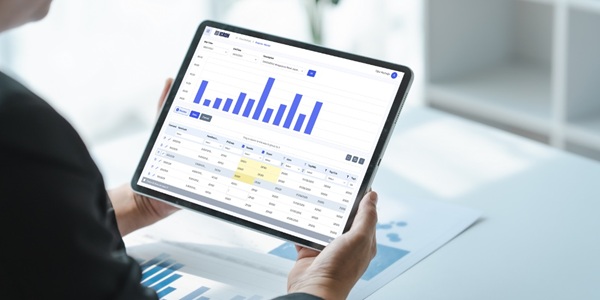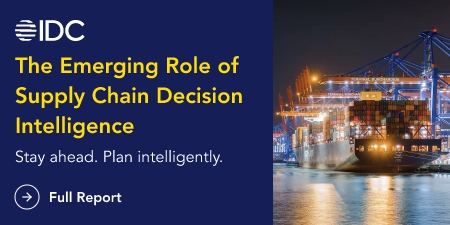
From natural disasters to geopolitical tensions, from supplier bankruptcies to cybersecurity threats, companies experience significant supply chain disruptions that last a month or longer every 3.7 years on average. [1] Each of those disruptions bears a potentially significant financial cost – and is where supply chain risk management (SCRM) becomes essential.
In this blog, we’ll look at the definition of supply chain risk management, its significance, the key components of risk management strategy – and how ICRON can help you with its implementation.
What is Supply Chain Risk Management?
Supply chain risk management (SCRM) involves identifying and reducing vulnerabilities within the supply chain before a disruption occurs, either preventing them entirely or minimizing their impact.
At its core, SCRM encompasses the processes, tools, and strategies used to manage both everyday operational risks and unpredictable or exceptional disruptions. It extends beyond your immediate business operations to include:
- Suppliers
- Transportation networks
- Distribution centers
- Customers’ supply chains
The Significance of SCRM in Today’s Business Environment
Global supply chains have grown – and will continue to become– increasingly complex, [2] with businesses often relying on hundreds or even thousands of suppliers spread across multiple continents.
This also stands true for supply chains’ value and importance, with organizations with high-performing supply chains capable of revenue growth far surpassing those without. [3]
Factors driving the critical need for SCRM include:
- Globalization of supply networks increasing exposure to regional disruptions
- Just-in-time (JIT) inventory practices reducing buffer stocks that previously absorbed shocks
- Growing cybersecurity threats targeting supply chain vulnerabilities
- Increased regulatory scrutiny of supply chain practices
- Rising customer expectations for availability and delivery
Key Components of Supply Chain Risk Management
A well-implemented SCRM consists of several interlinked components.
Risk Identification
The foundation of effective SCRM begins with comprehensive risk identification, during which you can systematically uncover potential threats to your organization’s supply chain.
Common methods for detecting supply chain risks include:
- Supplier vulnerability assessments evaluating financial stability, geographic location, and operational practices
- Environmental scanning for geopolitical factors, potential climate-related events, and regulatory changes
- Value chain mapping to identify critical nodes and potential bottlenecks
- Historical disruption analysis to identify recurring patterns
Risk Assessment and Evaluation
Once you identify potential risks, you can evaluate and prioritize them based on likelihood and potential impact.
Effective risk assessment techniques include:
- Probability and impact matrices to visualize risk severity
- Scenario planning to explore various disruption possibilities
- Quantitative risk modeling to estimate financial impacts
- Stress testing critical supply chain areas
Risk Mitigation Strategies
After risks have been assessed and identified, you can begin to develop actionable risk mitigation plans. These strategies typically fall into four categories:
- Avoid. Stop using high-risk suppliers or regions. For example, avoid sourcing from areas prone to political unrest or natural disasters to eliminate potential disruptions
- Transfer. Use contracts or insurance to shift risk. You could require suppliers to carry liability insurance, for instance, or use third-party logistics with guaranteed delivery terms
- Reduce. Diversify suppliers, hold buffer stock, or improve demand forecasting. These steps help lower the chance and impact of delays, shortages, or quality issues
- Accept. Tolerate minor delays or cost increases. This works when the risk is low-impact or fixing it would cost more than the problem itself
Benefits of Implementing SCRM
Well-implemented SCRM strategies offer a range of benefits for organizations. In this section, we’ll put a few of the most common under the microscope.
Enhanced Operational Resilience
Perhaps the most significant benefit of supply chain risk management is operational resilience. The ability to absorb supply chain disruptions without catastrophic failure or high financial cost puts organizations in the top 10% of companies worldwide. [4]
Such resilience translates directly to competitive advantage, allowing you to continue serving customers while less-prepared competitors struggle to respond to the same disruptions.
Improved Supplier Relationships
Effective SCRM requires close collaboration with suppliers, which often leads to stronger business relationships.
These collaborative approaches can lead to:
- Increased transparency throughout the supply chain
- Early warning of potential disruptions
- Joint problem-solving capabilities should issues arise
- Shared investments in risk reduction initiatives
All told, these can result in higher rates of on-time or successful deliveries, as well as reduced costs throughout the supply chain. [5]
Regulatory Compliance and Risk Reduction
Supply chains face increasing regulatory scrutiny across multiple dimensions, from environmental impact to labor practices to trade compliance. Additionally, many insurance providers and investors now evaluate supply chain risk management practices when determining coverage options and investment decisions, making SCRM directly related to financial protection and access to capital.
Challenges in Supply Chain Risk Management
SCRM strategies face multiple challenges that require near-constant attention. Here are a few of the most pressing.
Complexity of Global Supply Chains
On average, large companies use more than 5,000 suppliers throughout their global supply chains. [6] This means they must navigate factors like cultural differences, language barriers, and varying legal systems, while attempting to maintain visibility into multi-tiered supplier networks, where risks may be hidden several layers deep.
Data Management and Integration
SCRM requires processing enormous volumes of data, often from separate sources. This presents challenges to companies on numerous fronts, including:
- Siloed information across different departments or facilities
- Incompatible data formats from various systems
- Lack of real-time visibility into supply chain operations
- Difficulty separating signal from noise in vast data sets
Continuous Monitoring and Adaptation
Supply chain risk management is never “complete”; it requires ongoing vigilance and adaptation as supply chains change and evolve. Proper supply chain monitoring requires dedicated resources, which can be difficult to maintain.
Best Practices for Effective SCRM
Your supply chain risk management strategies should rely on several industry-proven best practices. We’ll outline them below.
Develop a Comprehensive Risk Management Framework
Successful SCRM begins with establishing a structured framework that defines responsibilities and processes for teams, departments, and facilities.
Your SCRM framework should:
- Align with overall business objectives and risk tolerance
- Clearly define roles and responsibilities for risk management
- Establish consistent methodologies for risk assessment
Engage in Regular Risk Assessments
Risk identification and assessment should become routine business practices rather than occasional exercises. Conduct assessments at scheduled intervals, as well as at points of change for your business – such as entering new markets, launching new products, or in response to external events that have the potential to affect your organization’s supply chain.
Invest in Technology and Data Analytics
Modern SCRM increasingly relies on advanced technologies to identify, monitor, and respond to risks. Organizations that use advanced analytics and technology in their supply chain risk management strategies perform higher in almost all metrics of supply chain management. [7]
Promising technologies include:
- AI-powered supplier risk monitoring platforms
- Blockchain solutions for supply chain transparency
- Internet of Things (IoT) sensors for real-time monitoring
- Digital twins for supply chain simulation and testing
Foster Collaborative Relationships with Suppliers
Risk management shouldn’t stop at organizational boundaries. Companies that have implemented collaborative risk management programs with suppliers experience fewer disruptions, and can respond more quickly than 83% of competitors when they do. [8]
When collaborating with suppliers, consider using the following
- Joint risk assessment workshops
- Shared contingency planning
- Transparent communication channels
- Aligned incentives for risk reduction initiatives
Case Studies: Successful SCRM Implementation
Here’s a look at two global companies that are using SCRM strategies to great effect.
Kingfisher’s Strategic Inventory Management
Home improvement retailer Kingfisher prepared for holiday demand by shipping Christmas stock six weeks early to proactively approach ongoing supply chain disruptions caused by rebel attacks in the Suez Canal. [9]
The company also took strides toward optimizing overall inventory management, [10] resulting in reduced inventory by £107 million in stores that were already open last year, an additional £20 million worth of inventory for new stores, and reduced net inventory time by six days.
Reckitt’s Investment in Foreign Production
Consumer goods manufacturer Reckitt took a different approach to supply chain risk mitigation by opening a new manufacturing facility for cold medicine in the United States, the company’s largest market for over-the-counter pharmaceuticals. [11] The new facility allows Reckitt to respond quickly to fluctuations in consumer demand, as well as decrease shipping time and costs for products for US-based customers.
However, Reckitt’s supply chain may be put to the test again in the face of US-imposed tariffs. [12] The situation’s fluidity and uncertainty will require the company to be adaptive to sudden change.
Future Trends in Supply Chain Risk Management
The future of SCRM lean heavily on technology-powered solutions to supply chain management.
Integration of Artificial Intelligence and Machine Learning
SCRM will be increasingly data-driven, with artificial intelligence and machine learning playing central roles in risk identification and assessment.
AI applications in supply chain risk management include:
- Predictive disruption modeling based on early warning signals
- Automated supplier risk scoring using multiple data sources
- Natural language processing to monitor news and social media for disruption indicators
- Inventory planning optimization to reduce region-specific risks
Emphasis on Cybersecurity Measures
As supply chains become more digitally connected, cybersecurity emerges as a critical risk management priority. Assessing suppliers’ IT systems will be key here – especially in regards to data sharing – as will the development, implementation, and refinement of authentication methods for digital transactions.
Shift Towards Sustainable and Ethical Sourcing
Environmental and social governance (ESG) factors are becoming integral to supply chain risk management. Forward-thinking organizations are already incorporating sustainability into their risk frameworks by assessing climate change impacts on supplier locations, for example, or evaluating resource constraints such as water scarcity.
Develop an Effective Supply Chain Risk Management Strategy with ICRON
ICRON’s suite of AI-powered solutions connect data, people, and processes for better, faster, decisions – so you can take a proactive approach to supply chain-related risks.
Ready to see how ICRON can provide you with the platform you need to build a robust SCRM strategy? Get in touch now!
- https://www.mckinsey.com/capabilities/operations/our-insights/risk-resilience-and-rebalancing-in-global-value-chains
- https://www.pwc.nl/nl/assets/documents/pwc-supply-chain-and-risk-management.pdf
- https://www2.deloitte.com/content/dam/Deloitte/fpc/Documents/services/supply-chain-et-achats/deloitte_supply-chain-trends_en_sept2014.pdf
- https://www.bcg.com/publications/2022/necessity-to-build-operational-resilience-framework
- https://www2.deloitte.com/us/en/blog/business-operations-room-blog/2024/supply-chain-collaboration-for-resilience.html
- https://www.mckinsey.com/industries/public-sector/our-insights/effectively-implementing-president-bidens-supply-chain-review
- https://www.gartner.com/en/newsroom/press-releases/2024-02-20-gartner-says-top-supply-chain-organizations-are-using-ai-to-optimize-processes-at-more-than-twice-the-rate-of-low-performing-peers
- https://www.supplychainmovement.com/83-of-supply-chains-unable-to-respond-to-disruptions-within-24-hours/
- https://www.reuters.com/business/retail-consumer/bq-owner-kingfisher-well-stocked-christmas-early-shipping-pays-off-2024-11-25/
- https://www.kingfisher.com/~/media/Files/K/Kingfisher-Plc/Universal/investors/result-reports-presentation/2025/2024-25-full-year-results-presentation.pdf
- https://www.wsj.com/articles/reckitt-prescribes-more-u-s-production-for-drug-supply-chain-ec0fefed
- https://www.reuters.com/business/retail-consumer/trade-war-intensifies-reckitt-may-be-more-exposed-than-some-rivals-2025-03-17/












